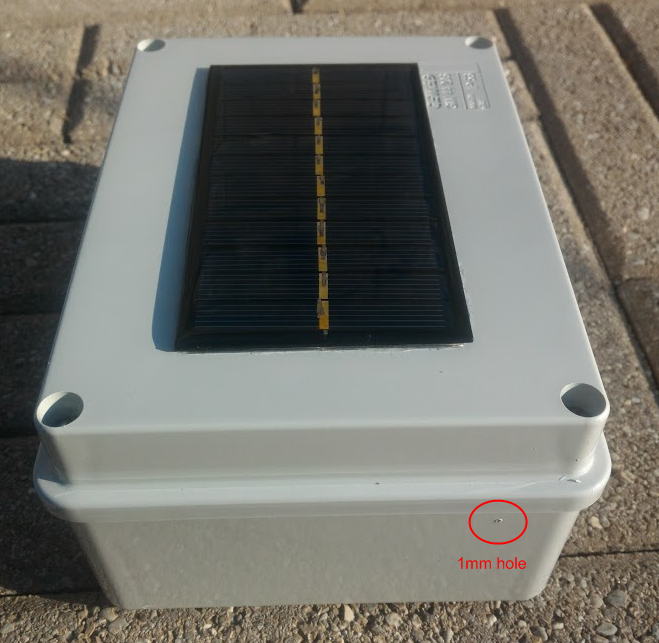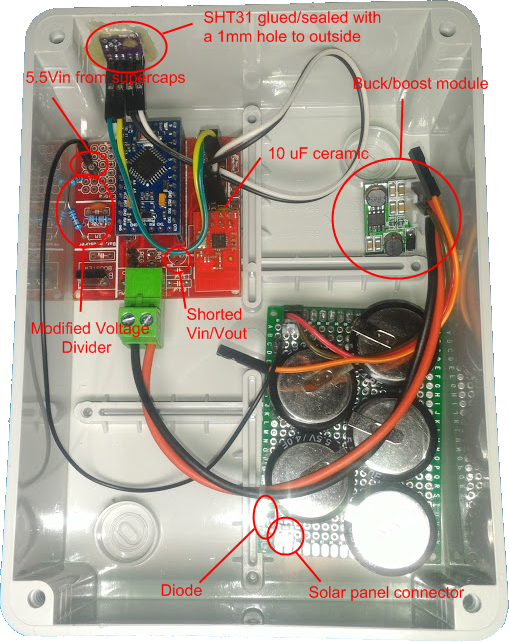Supercap Solar Powered Mysensors nodes as cheap as possible
-
The LiFePO4 battery setup was unable to charge the battery (maybe because I didn't study how to charge those batteries). I am now back to the 5V supercaps but with the HW radio to see how it works and I noticed the TX power dropped from 40% to 0% so the power amplifier is actually doing its job
-
Also the buck/boost module has some low voltage issues when voltage drops below 1.4V it start drawing 130/140mA and I needed to increase voltage to 1.7V (where it was drawing 240mA) before it started to supply the correct voltage for the node to boot and have the current back to a normal 20/40mA.
I need to find a solution for recovering the node after the booster goes crazy and that would require for sure using a voltage detector like @NeverDie suggested but that is going to require making a custom PCB with integrated booster for the 3.3v output and the supercap charger mentioned earlier.
Is anybody willing to help? :sweat_smile: -
Andreas Spiess did a whole video on how to properly charge supercaps in series. Gohan's supercaps were just soldered together without those protections to get their 5.5v rating. Maybe it was that. Or, since it was outdoors, maybe corrosion got to them.... It would be interesting to hear what Gohan's post-mortem reveals. As Edison would say, Gohan learned a new way of how not to do it. That still leaves a lot of ways that it could be done though.
-
No idea really, the box was sealed. I suspect they might have gotten unbalanced. About charge cycles I don't think they were a problem since they probably had less than 400 (1 cycle a day). They were cheap Chinese parts, so poor quality for sure given the self discharge rate they had. Given the cost of a LiFePO4 battery compared to supercaps, I think I'm going to take the battery route and ditch the whole solar power. I have an identical node running on a single AA LiFePO4 and in 8 months it barely discharged even if it is sending 4 values every 10 minutes
-
I've forgotten, but didyou do any protection circuit for your supercaps to keep each one from overcharging? Julien Ilett tested some and found that not all of Chinee circuits stopped the charging at 2.7v, but instead allowed them to go to 2.8 or 2.9v instead:
https://www.youtube.com/watch?v=r7M6Pb2roLs&t=180s
So, maybe that's what happened to the yours that leaked. -
Small update after some time running on 2 100F supercaps in parallel

Voltage seems consistent over time

Here you can see the transition from the 5.5v supercaps to the normal ones, the odd thing is that it seems the supercaps took a few days to accept higher charge voltage
-
I may misunderstand how they work, but I've had the idea that (super)caps are better in short term high current situations. Like regenerative brakes for robot lawnmowers, not slow drain low power devices. It sounds to me like the life boat is the lifepo4 batteries. I'm all for experiments, so please dont stop, but unless the environmental conditions are intolerable for the batteries, I'd say you found your answer.


